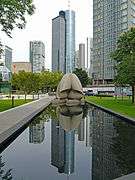Dominique Stroobant
Dominique Stroobant (born March 16, 1947) is a Belgian sculptor, photographer and graphic artist living in Italy.
Dominique Stroobant | |
|---|---|
 | |
| Born | March 16, 1947 Antwerpen, Belgium |
| Occupation | Photographer and sculptor |
| Spouse(s) | Mymona („Mona“) Johnson
( m. 1973; death 1998) |
Life
Since 1970 he has been living in Carrara, where he resides and works in the small hamlet of Miseglia.[1][2]
In 1972 he created with Kenneth Davis and Philippe Toussaint the Floating Stones Group.
In 1976 he started his collaboration with the enterprise Fratelli Biselli SpA, one of the first two to cut granite since the 1950s in Carrara.[3]
With Paolo Gioli he was one of the photographer who developed pinhole photography[4] in Europe.[5][6] In 1977 he documented with his selft-built[2] pinhole camera the movement of the sun.
He worked with Max Bill. Amongst their most important artwork is the sculpture Kontinuität in Frankfurt.[7]
He has been a friend and collaborator of ZERO artist Jef Verheyen.[8]
In 1988 he carved a memorial for the casualties of the 1956 mining accident of Marcinelle, inside the site of the coal mine.[1]
In 2013 he was the moderator at the round table discussion "Visivi. La fotografia attraverso i linguaggi contemporanei" ("Visual. Photography through contemporary languages"), in Florence at Museo Galileo[9].
Work
Stroobant was mainly known in his early years for the investigation of the reuse of industrial materials, but later focused his attention on political and philosophical themes. [2]
Everyone at Carrara knows that stone weeps. ... All of us have experienced how alive stones are, that they behave like sponges, can bend, expand and that they have a voice ... for one who listens
Another the crucial aspect of his activity is also the role of scientific principles in art.[2]
Gallery
 Kontinuität, Max Bill and Dominique Stroobant, 1983-1986 based on a project of 1947
Kontinuität, Max Bill and Dominique Stroobant, 1983-1986 based on a project of 1947- Memorial in Marcinelle, Belgium
Books
- Stroobant, Dominique (1982). Camera Oscura. Hendel Teicher. ASIN B00BBQ848C.
- Dominique Stroobant. MER. Paper Kunsthalle. 2016.
Documentaries
- Behind these Stones - Dietro i sassi Film and Photography Catalogue presented at the 37th Venice Biennale, Flemish Ministry of the Arts, Belgium, (1976)
- Non son l’uno per cento, anarchici a Carrara (I am not the one percent, anarchists in Carrara), Antonio Morabito (2006)[12]
Exhibitions
- Behind those stones, Biennale of Venice, 1978.[13][14]
- L'art et le temps. Regards sur la quatrième dimension, Institut d'art contemporain de Villeurbanne, December 1985-January 1986[15]
- The international Pinhole Photography exhibition, Contemporary Arts Museum Houston, June 30 – September 9, 1990[16]
- Senza Obiettivo, International Exhibition of Pinhole Photography, Santa Maria della Scala (Siena) Museum, October 31 - November 17, 2002, Siena - XI Visionaria Festival[17]
- Artempo at Fortuny Museum[18][19] a show by curator and interior designer Axel Vervoordt's that investigates time in art.[2]
Personal life
He met in 1969 South-African Mona Johnson (from Cape Town) and had two children, Ish-maël (*1972) and Mascha (*1978).
References
- Carpita, Cinzia (13 August 2012). "Così ho scolpito i morti di Marcinelle. Dominique Stroobant: l'artista belga-carrarino racconta". Il Tirreno (in Italian).
- Bhui, Hannah (9 June 2014). "A visit to the Carrara marble quarries with sculptor Dominique Stroodant". Purple.
- Bromberger, Christian (2016). Carrières d'objets: Innovations et relances (in French). Éditions de la Maison des sciences de l’homme. p. 32. ISBN 9782735118656.
- Renner, Eric (2012). Pinhole Photography: From Historic Technique to Digital Application. Taylor & Francis. ISBN 9780240810478.
- Jon, Grepstad (2015-10-20). "Pinhole Photography – History, Images, Cameras, Formulas". jongrepstad.com. Retrieved 11 March 2017.
In the USA, however, critics tended to ignore pinhole photography in art, whereas Paolo Gioli and Dominique Stroobant received more attention in Europe
-
I primi “scatti” di sei mesi furono dell 1979 e publicati l’anno dopo (ICC, Antwerpen). La prima recensione in Italia è dell giugno 82 nella rivista Reflex. e poi publicate in numerosissime occasioni. (Romano Fea in Fotografare) . numero 47 (2001) di Pinhole Journal - descrizione detagliata del procedimento
— Dominique Stroobant, comment in Smargiassi, Michele (16 April 2010). "Un lunghissimo istante". Repubblica.it (in Italian). Retrieved 14 March 2017. - Thomas, Angela (June 2012). "vielschichtige drehpunkt-persönlichkeit" (PDF). www.maxbill.ch (in German). Retrieved 11 March 2017. English version
- "Jef Verheyen oeuvre shared Jef & Dominique Stroobant". www.jefverheyen.com/. Retrieved 15 March 2017.
- "Visivi. La fotografia attraverso i linguaggi contemporanei" (in Italian). Museo Galileo. 3 May 2013. Retrieved 31 October 2018.
- Leitch, Alison (December 2010). "Materiality of Marble: Explorations in the Artistic Life of Stone". Thesis Eleven. 103 (1): 65–77. doi:10.1177/0725513610381375.
- "EVENTS ARCHIVE - 13 November 2016 2pm - Sigmund's Shorts: In the Flesh (2016)". www.freud.org.uk. The Freud Museum. Retrieved 15 March 2017.
- "Non Sono l'un percento". Retrieved 11 March 2017.
- Leitch, Alison (2007). "Visualizing the mountain: the photographer as ethnographer in the marble quarries of Carrara". Journal of Modern Italian Studies. 12 (4): 417–429. doi:10.1080/13545710701640764.
- Titolo La Biennale di Venezia (in Italian). 37 (1 ed.). 1976.
- "L'ART ET LE TEMPS REGARDS SUR LA QUATRIÈME DIMENSION".
- "THE INTERNATIONAL PINHOLE PHOTOGRAPHY EXHIBITION".
- "Senza obiettivo (without lens): pinhole photography exhibition in Siena". domusweb.it/en. 2002.
- "ARTEMPO - where times becomes art - contributing artists". fortuny.visitmuve.it/en/home/. 2012.
- "ARTEMPO - where times becomes art - Il percorso". fortuny.visitmuve.it/en/home/ (in Italian). 2012.
External links
- "Dominique Stroobant-Biography". www.axel-vervoordt.com/. Retrieved 13 March 2017.
- "Dominique Stroobant". Retrieved 14 March 2017.